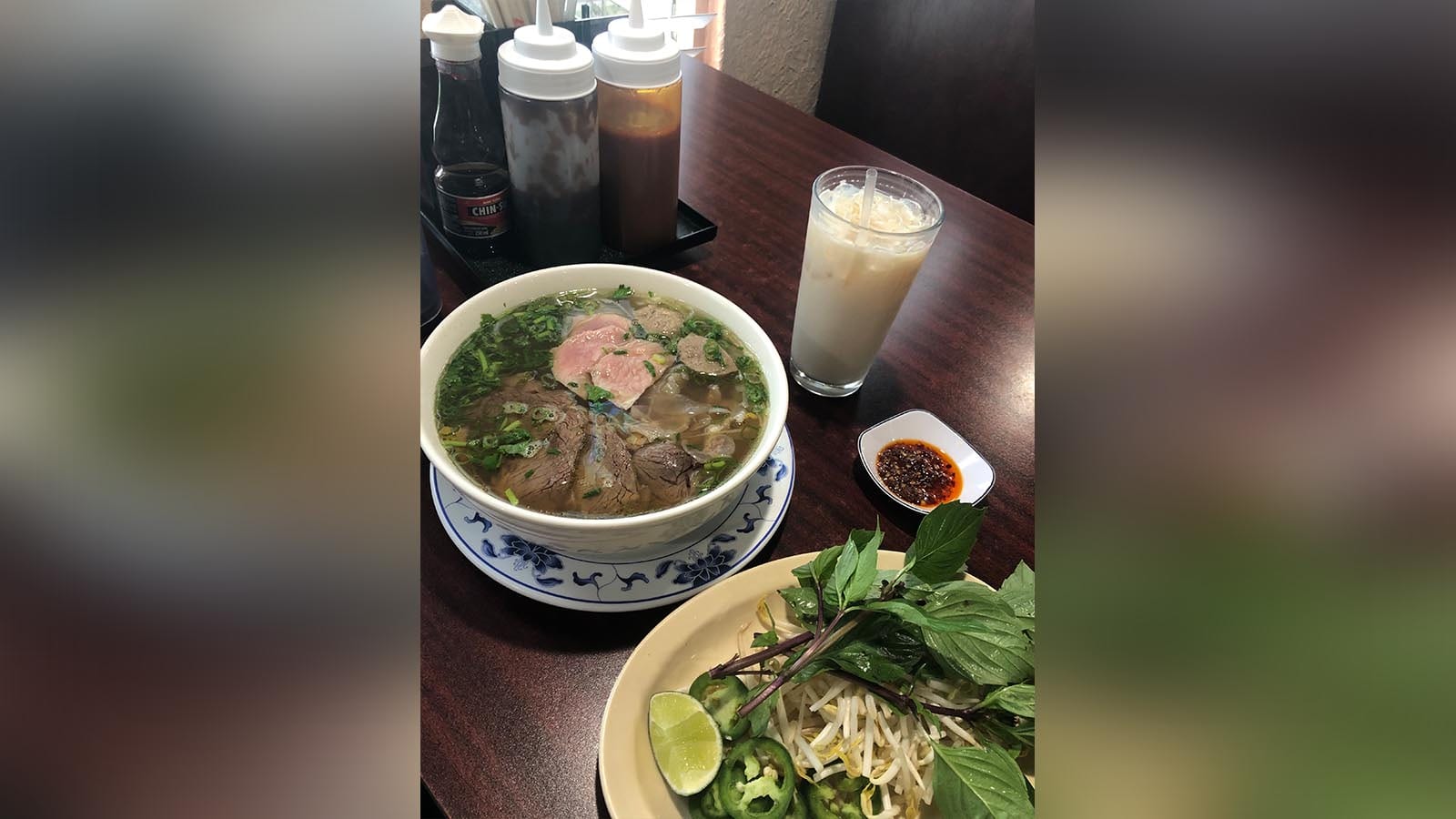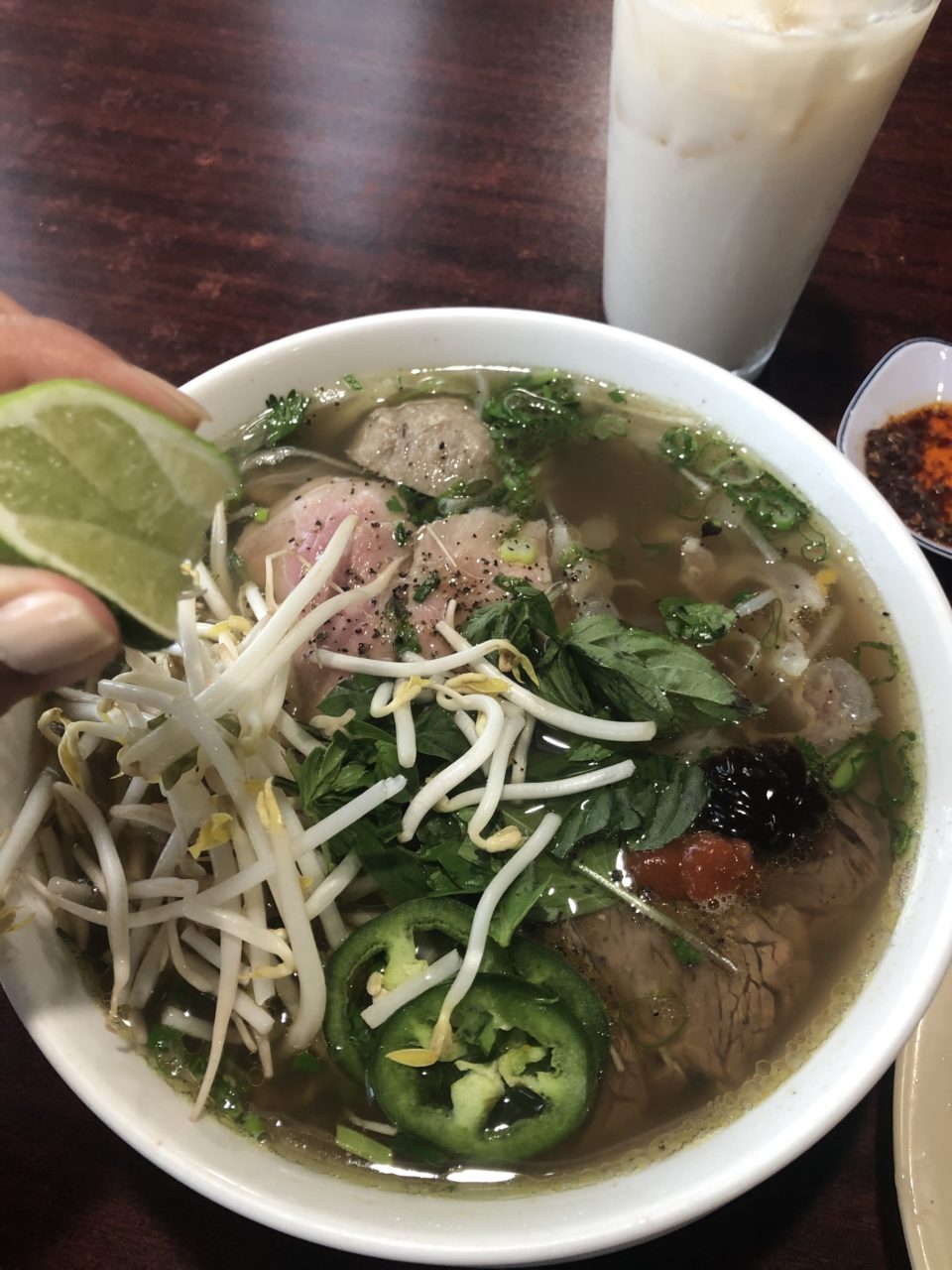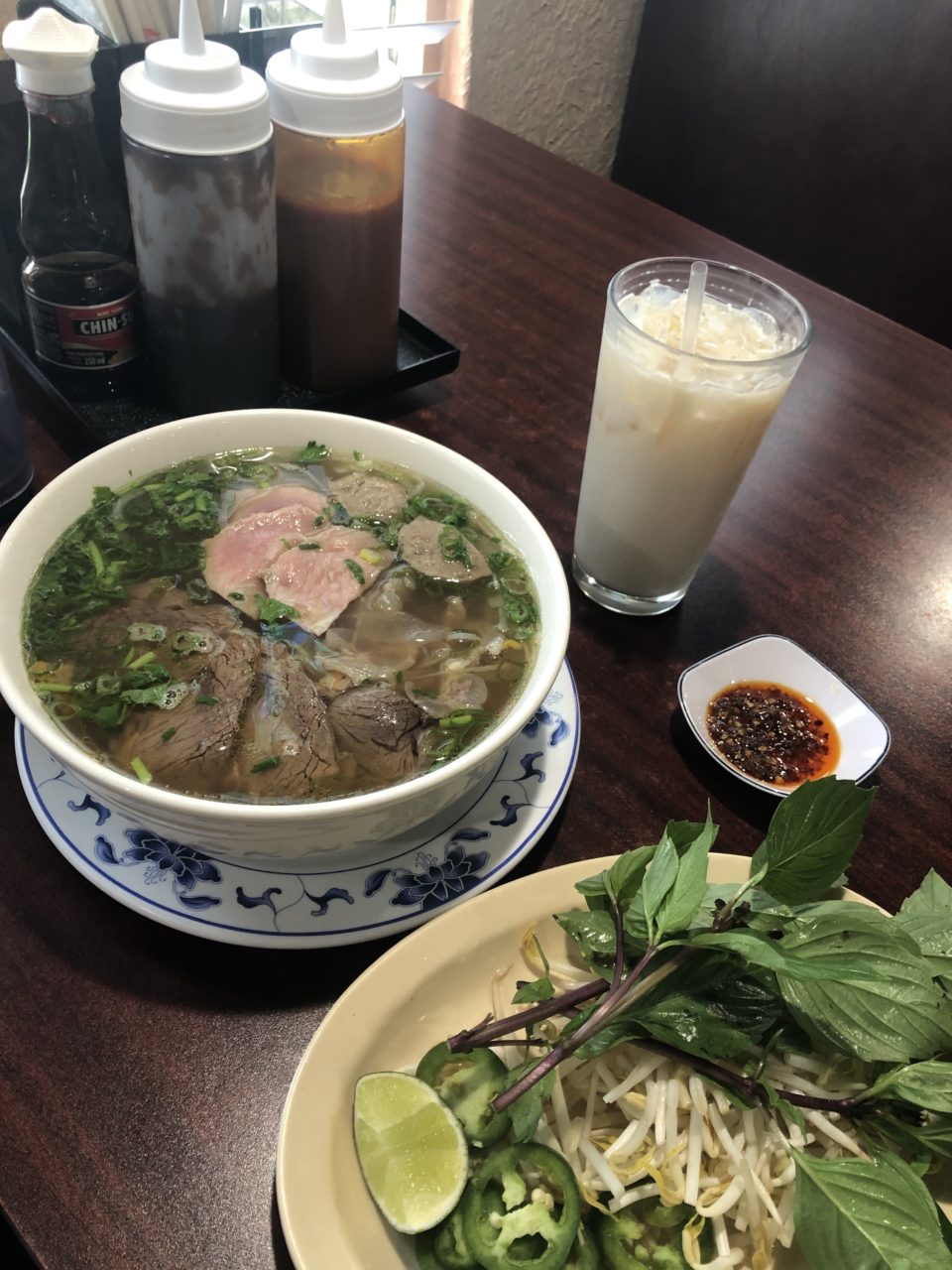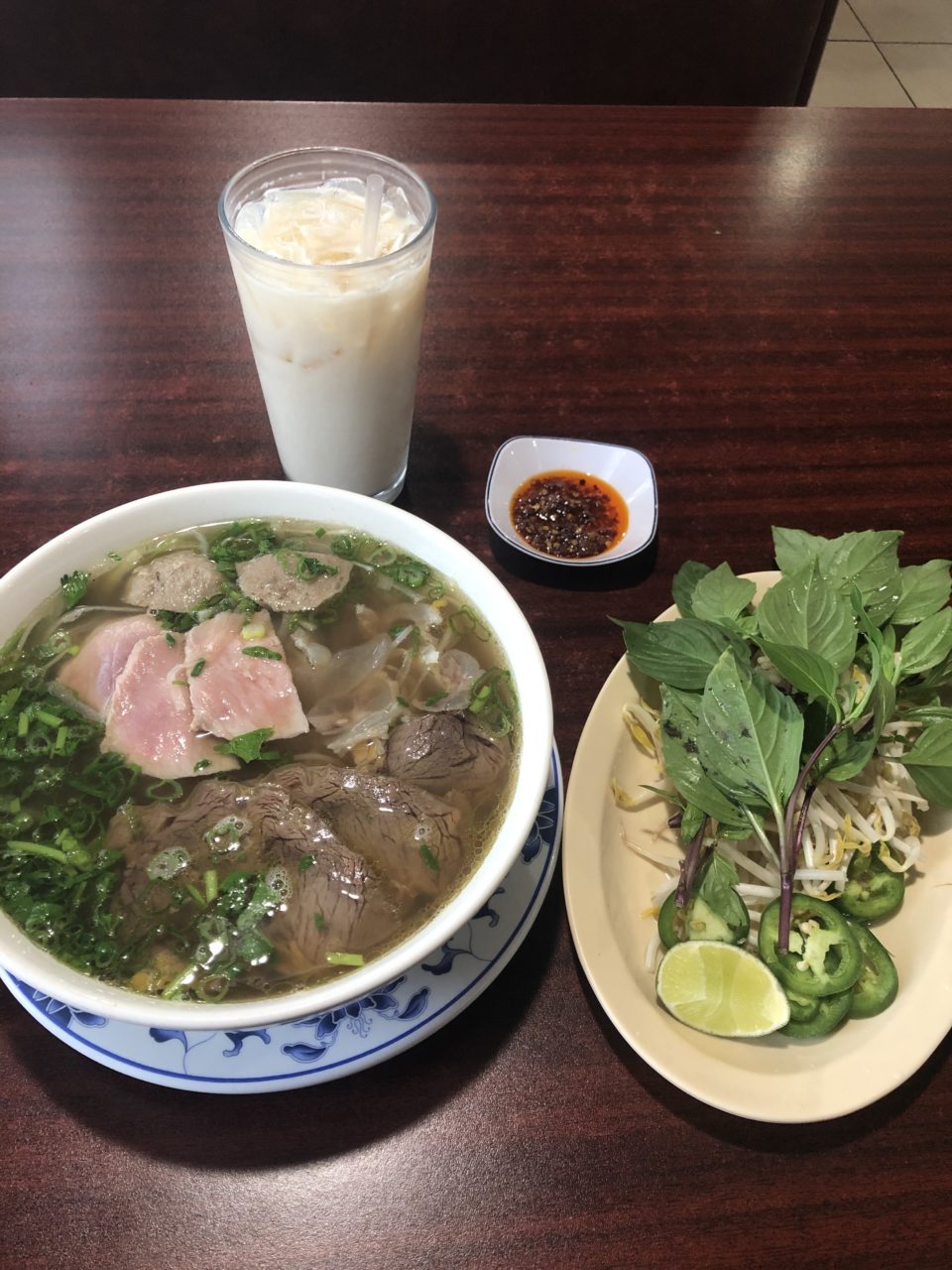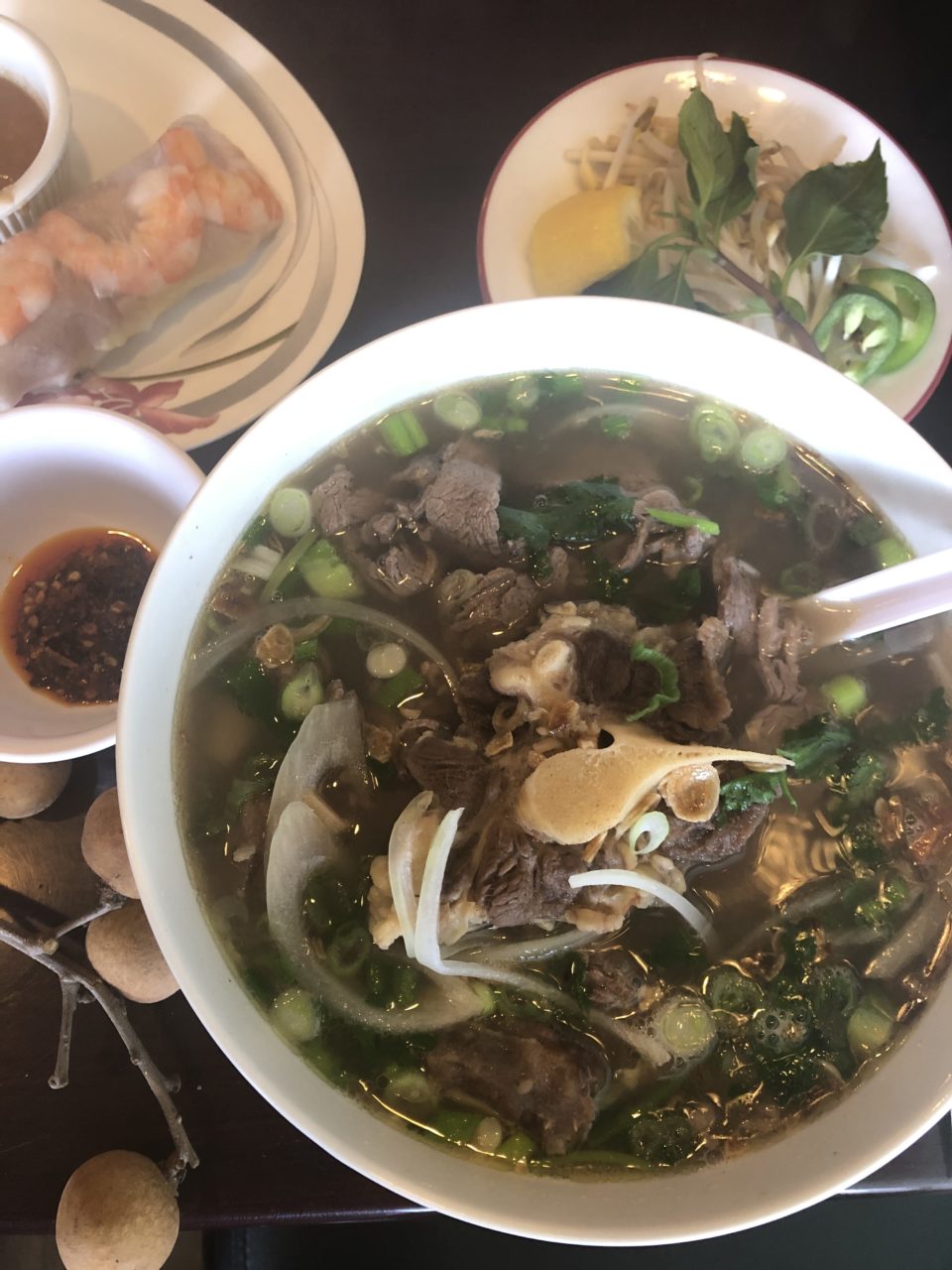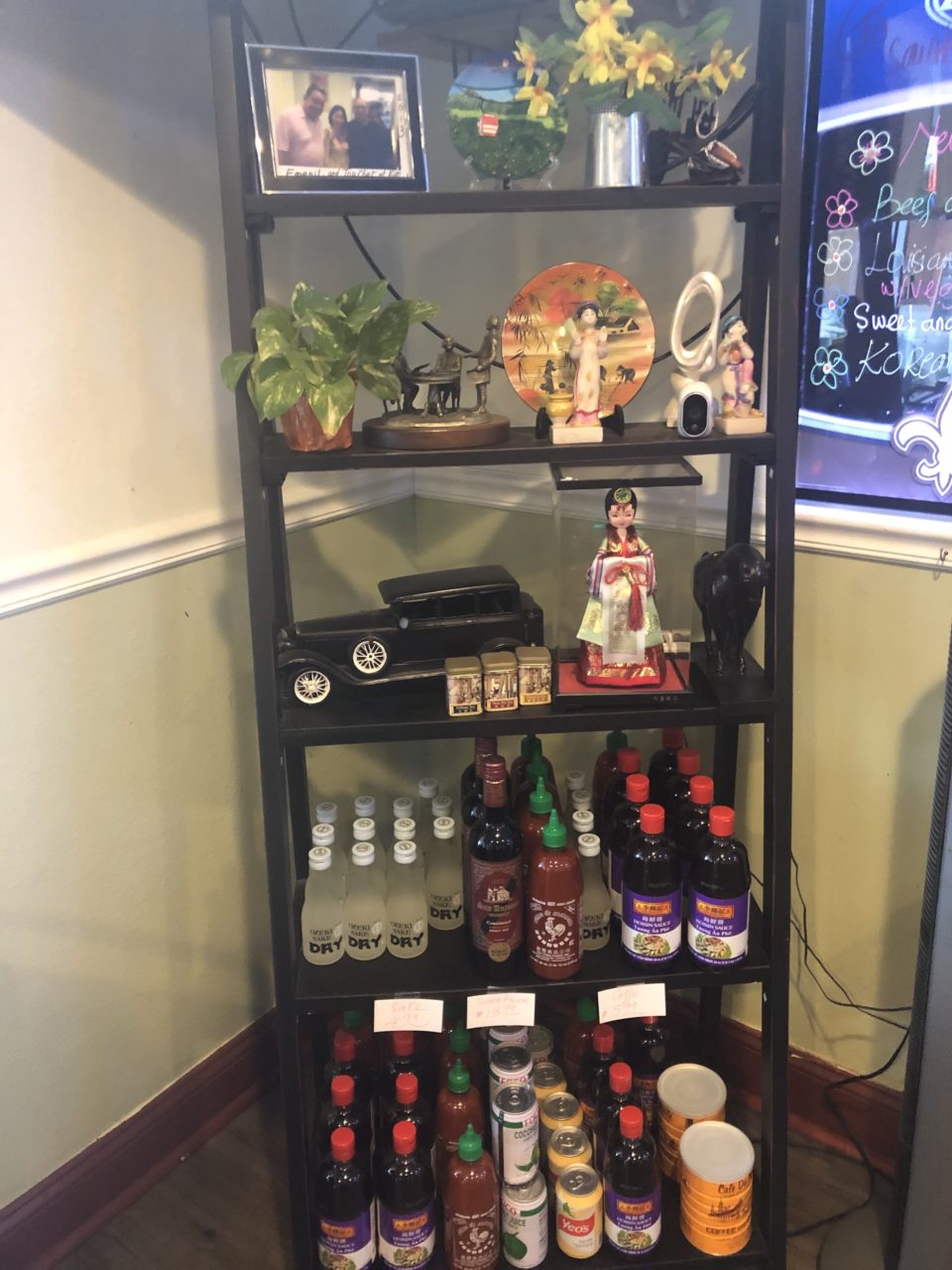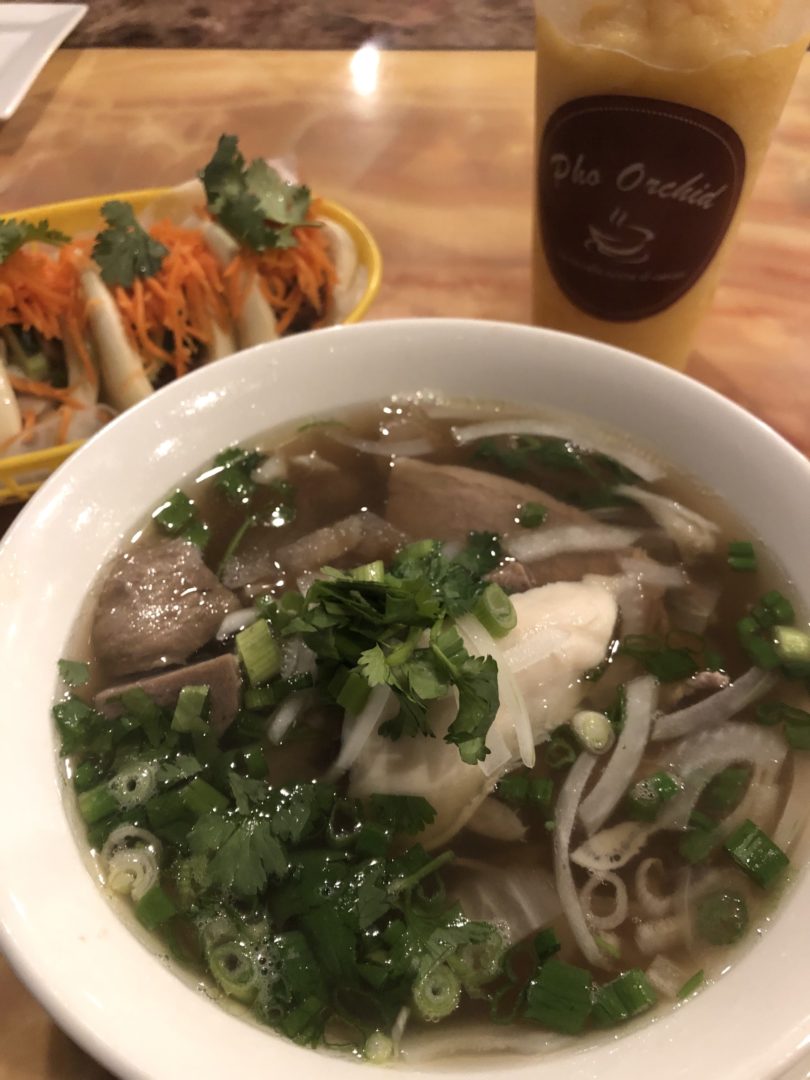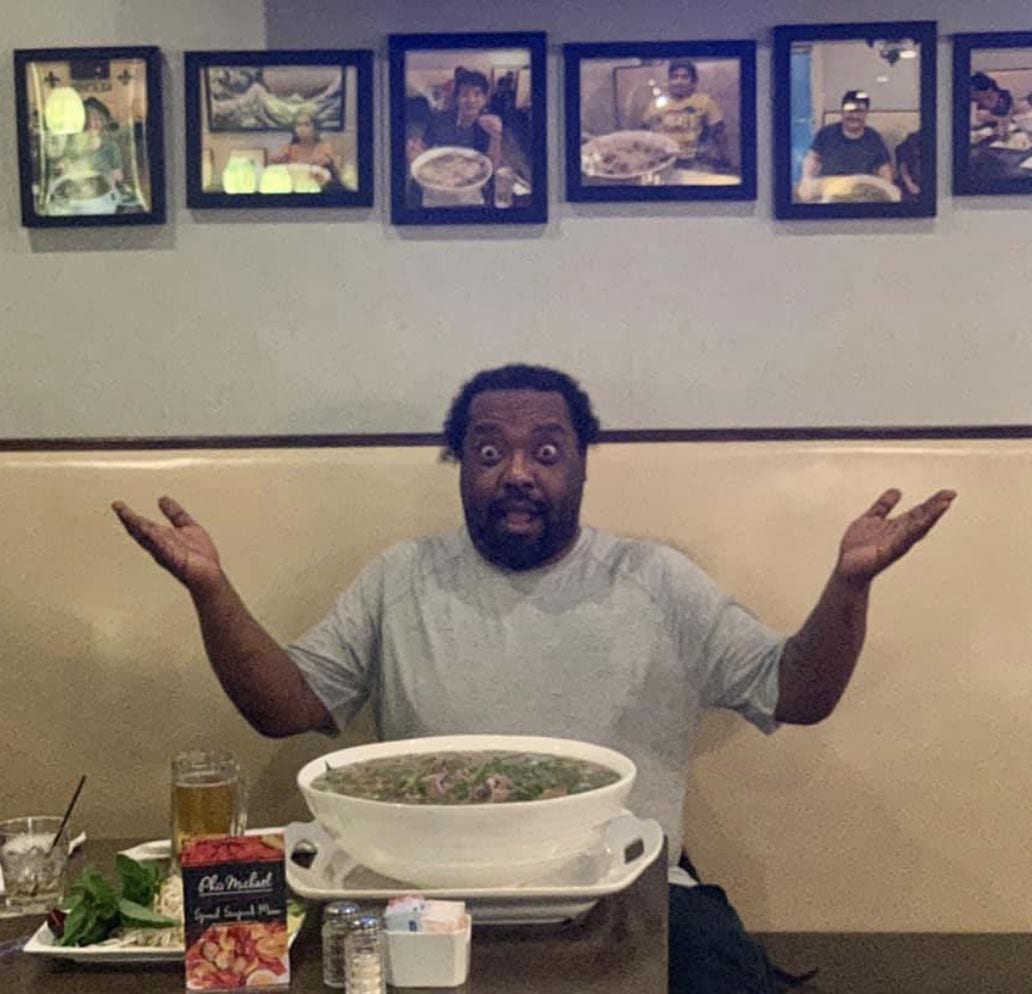Surprise surprise, it’s raining and the @NOLAready flood warnings aren’t stopping as we transition full speed ahead into hurricane season. This means that I’ll be hitting that snooze button, since I couldn’t even dare to hit these flooded streets. This dreary morning also means that I’ll be hankering for a hot, comforting bowl of phở once I wake up.
“Not pho dinner?”
Growing up in Algiers, I used to ask my #DaddyfromDaNang: “How come phở restaurants like Phở Bang (his favorite) operate business hours like 8 a.m.-5 p.m.? They’re missing out on people who would want to eat dinner around 6-8 p.m..”
His response: “You crazy, girl. Nobody eats phở for dinner!”
Now that I’ve learned how much of a labor of love it is to make a good bowl of phở, it makes sense: the rich bone broth must simmer overnight, and the stalls in Vietnam would open before sunrise to be able to sell out before the day became swelteringly hot. This soup is not only fortified with protein, it is laced with natural anti-inflammatory spices including ginger, anise and cinnamon to begin the day with something warm, filling and restorative.
A brief history
Perhaps why dishes like phở are so beloved and comforting to New Orleanians is due to the blatant parallel between traditional New Orleans Creole cuisine and Vietnamese cuisine: both native lands were colonized by the French at some point (1682 for New Orleans; 1857 for Vietnam). Considered the national dish of Vietnam by many, phở’s culinary roots stem from making the most of what they’re left with to feed their families and community. Some historians even posit that the French term for a beef soup, “pot-au-feu” had some influence in the name, “phở;” as the phởnetic (see what I did there?) Vietnamese shorthanded pronunciation of “-feu.” Alternately, some historians draw a phởnetic parallel between the Chinese word for the thin, flat rice noodles: “phấn” and what has now become the Vietnamese term for those same type of rice noodles: “phở.” The increased availability of beef due to French demand in turn produced beef bones that were used by the Vietnamese and Chinese communities to create this nourishing, protein-rich broth that could feed the masses cheaply and resourcefully.
Historically, phở originated in northern Vietnam and spread throughout the country as we now know it, sometime in the early 20th century; with the 1954 Partition of Vietnam popularizing the dish in the south and finessing it with the garnishes of lime, basil, cilantro, mung bean sprouts, hoisin and sriracha sauce.* When the Fall of Saigon happened on April 30, 1975, over half a million Vietnamese sought refuge in the United States, with over 15,000 immigrating to New Orleans with the help of Associated Catholic Charities (ACC). A majority of Vietnamese settled in pockets of Algiers, Avondale and New Orleans East; with the recently vacated 402-unit Versailles Arms Apartment Complex being the housing identified by ACC for the initial wave of 1,000 refugees, and growing westward along Bayou Sauvage from there.** Versailles now boasts the densest Vietnamese population in the New Orleans area, with around 40% of its total Vietnamese population as its residents. For decades, the Vietnamese community was able to flourish, and were among the first to return to the city after Hurricane Katrina to rebuild.
“The humble ingenuity born from being forced to make something out of nothing is a testament to the resilient spirit of the Vietnamese people, who have been displaced time and again,” says District E Councilmember Cyndi Nguyen, a Vietnam-born resident of Versailles and the first Asian-American to hold a City Council seat. “It’s a story that all of New Orleans and Louisiana knows — and everytime we rebuild, we do it stronger, better and leave a little more of that brave legacy behind for our children to carry on.”
So where is Councilmember Nguyen’s favorite place to get phở? Starting with District E, these are five Vietnamese restaurants throughout the greater New Orleans area to get an authentic, traditional bowl of phở.
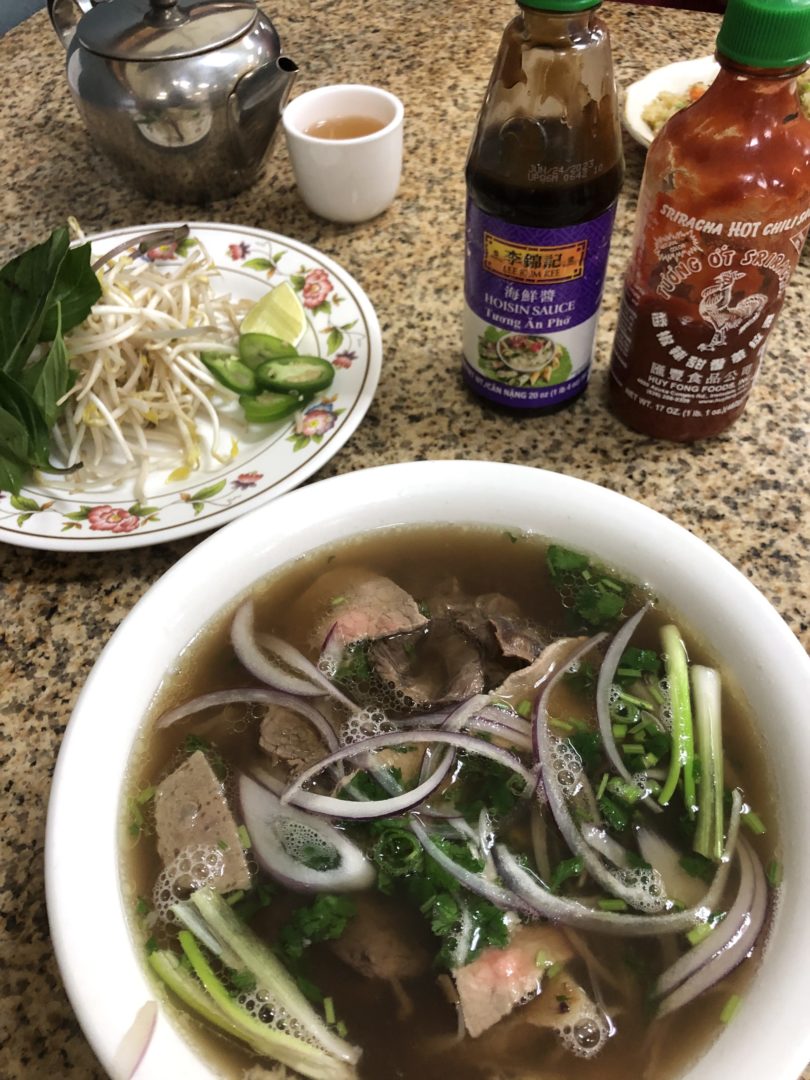
13235 Chef Menteur Hwy, Suite C New Orleans, LA 70129 | (504) 255-0500
Ba Miền means “Three regions,” because the owner Mai Nguyen wanted to capture traditional dishes from all three North, Central and Southern regions of Vietnam. True to the culinary origins of using simple and fresh ingredients to feed a crowd, Mai Nguyen turned her expertise as the eldest of eleven siblings into her dream of opening a restaurant and banquet hall. “For two decades, Ba Miền has been a cornerstone of celebrations for the Vietnamese community here in New Orleans East,” says Councilmember Cyndi Nguyen. Ba Miền offers traditional beef phở and chicken phở, as well as an extensive menu of Vietnamese dishes not often found in restaurants, such as Bánh cuốn, bánh ướt (steamed rice crepes/mini pancakes with ground pork filling) and Nem nướng Khánh Hòa (chargrilled sausage skewers with thin rice wraps, a specialty of coastal province Nha Trang in South Vietnam) and one of my favorite desserts, Chè Ba Màu (layered sweetened beans, agar-agar jellies and coconut).
Other notable restaurants in District E:
- Phở Bằng Restaurant (multiple locations throughout)
- Dong Phuong Restaurant & Bakery
- Em Trai Sandwich Co.
1530 Lapalco Blvd #1, Harvey, LA 70058 | (504) 900-1591
Being a westbank native, I would always argue that the best Vietnamese food is found on the bestbank side of the Crescent City Connection. There are so many staples that I have been going to for more decades than I care to admit — but my clear frontrunner for the past 5 years has been unmistakably Phở Kim Loan. Why? Because of the connection that I feel when I walk in as a first-generation immigrant who also once put in literal blood, sweat and tears alongside my family members to uplift their endeavors.
“It’s challenging, but very rewarding to see my parents happy and proud of what we’ve accomplished through a lot of struggles and sacrifices to be where we are today,” says Lauren Nguyen. She, her brother Tommy and mother Linda (Loan) typically manage the front of the house, while father Thien Nguyen is the chef.
“I learned how to cook when I was 9-years-old selling street food with my grandma in Trà Vinh; but I feel that it wasn’t until I came to America in 1985 that I learned to perfect the phở enough to open my own restaurant here in the heart of the Westbank in 2016,” said Thien Nguyen. Fifteen combinations of beef phở are offered, with the remaining 5 options to be topped with either sliced chicken, shrimp, fried tofu, or veggies. Technically, there’s one more traditional stew, bò kho, that uses the white phở noodles, but it’s topped with a heartier tomato-based stew more similar to a traditional French pot-au-feu or American beef stew, and very commonly eaten as breakfast with baguettes throughout Vietnam. Spicy Bún bò Huế, once the dish of the former royal court of central Vietnam, is one of their superstar dishes; and specials seldom found outside of a Vietnamese household such as Bún riêu (vermicelli noodle soup with crab and pork meatballs, fried tofu and tomatoes) are often featured.
Other notable restaurants on the Westbank:
- Tân Định
- 9 Roses Restaurant
- Three Happiness Restaurant
- Kim’s Noodle House
- Thanh Thanh Restaurant
- TD Seafood and phở House
- August Moon
- Le Dalat
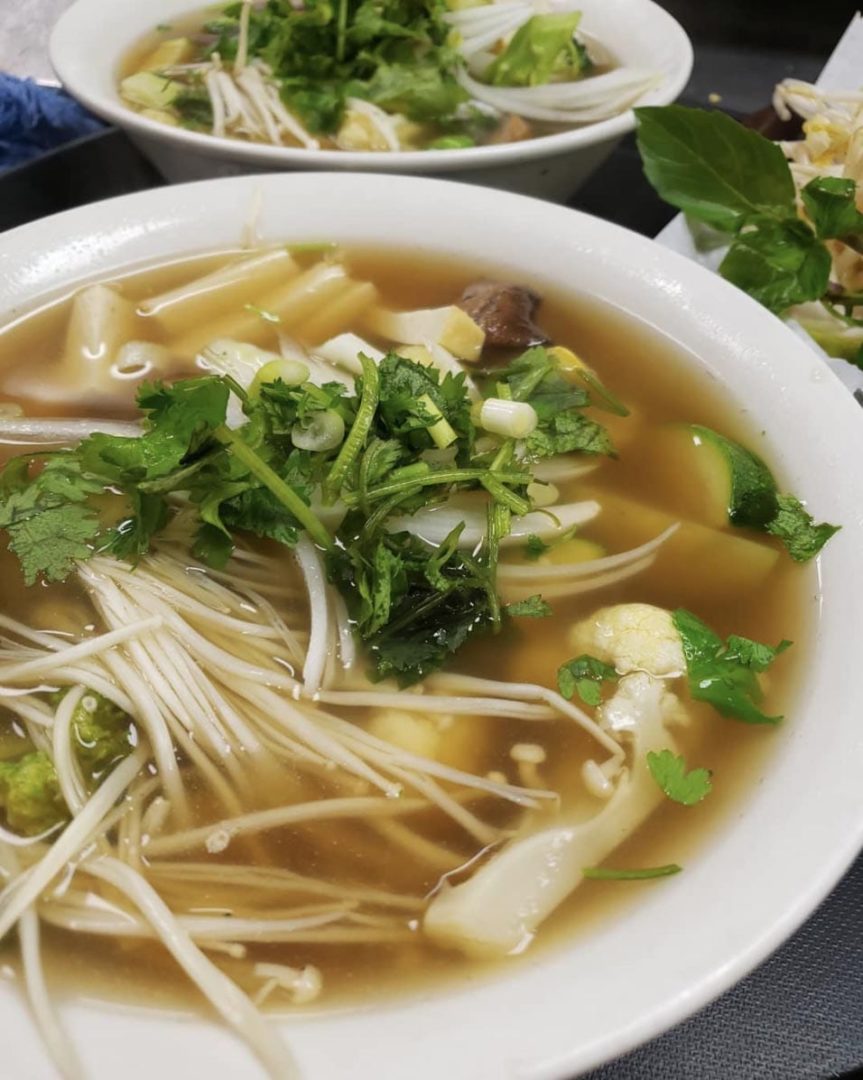
2005 Magazine St., New Orleans, LA 70130 | (504) 522-3399
When one wants comfort in a bowl in the heart of the Lower Garden District, Phỏ Noi Viet is another family-owned and operated Vietnamese restaurant. While Magazine Street has many excellent Vietnamese restaurants, again this is a restaurant in which the whole family dynamic is seen in action on a daily basis, and the menu offerings are more familiar to what you might find in a traditional Vietnamese household — most especially the Shaking Beef Bò lúc lắc and the light, coconut-based Vietnamese curry cà ri dishes. Simple, unpretentious and focused on extracting the most flavor out of what they’ve got. While the combinations of meats offered aren’t as extensive, featuring only the rare beef tái, cooked brisket nạm, beef balls bò viên, and chicken gà; the quality and portion of the meat is proportionate and balanced. From a phở perspective, what stood out to me what how intentional they were at creating a true vegetarian version of a phở broth; rather than just topping the phở with assorted vegetables regardless of how those veggies impact the flavor of the broth. Mind you; historical context requires that phở is based in either beef or chicken bones, but if we’re going to make a dietary accommodation, this is the way to do it — with thought to balancing the flavors so that it comes close to the traditional and familiar comfort food that phở is rooted in.
Other notable restaurants in the New Orleans in and around downtown:
- Phở Cam Ly
- Le’s Baguette Banh Mi Cafe
- Mint Modern Vietnamese
- Magasin Vietnamese Cafe
- Lilly’s Cafe
- Ba Chi Canteen
- Jazmine Café
- phở Bistreaux
- phở Kang
- Phở Tầu Bay Restaurant
- Viet Orleans Bistro
- Doson Noodle House
- Café Minh
- Mr. Bubbles Cafe
- Singleton’s Mini Mart
- Eat Well
6624 Jefferson Hwy, Harahan, LA 70123 | (504) 739-9995
Walking into Kim Anh’s Noodle House, 9.9 times out of 10 you’ll be greeted warmly by the owner, Teresa Vu, as she sits happily at her little station in the back corner, cleaning and sorting veggies or rolling silverware. She will likely share her snack of the day with you; and it will usually be the freshest fruit of the season. Last month it was navel oranges, this week it was an entire branch of longans. Started in 1994 as “Kim Anh’s Restaurant” in New Orleans East off Bullard Avenue by her parents, after Katrina forced its closure, Vu came back in 2006 to rebuild in Harahan. Not only does Kim Anh’s offer an extensive menu of southern Vietnamese classics, they are one of the few places that survived the COVID-19 pandemic to offer oxtail phở, as well as the option to have filet mignon as the sliced rare beef. The flavor of their phở is also differentiated by the addition of fried shallots to their broth, typically done for a similar southern-style soup called hủ tiếu, but seldom seen in phở. They’re mostly known in the area for their handmade hoanh thanh (wonton dumplings soup), and also for supplying a small selection of Vietnamese seasonings and condiments to an area where Vietnamese restaurants are few and far between. Did I mention they serve wine by the glass AND by the bottle, even if it’s the middle of the day?
Other notable restaurants in the Eastbank Jefferson Parish:
3117 Houma Blvd Metairie, LA 70006 | (504) 457-4188
Business Hours: Monday – Saturday 11am – 9pm, Sunday 11am – 8pm
Phở Orchid owner Tu “Dave” Nguyen opened the original Metairie location of Phở Orchid near Clearview Mall in 2009, and soon after opened an “Express” location with an abbreviated menu and more casual, quick-service feel on 1401 Airline Drive in 2013. He has served as a member of the Asian Pacific American Society (APAS) for some time, this year becoming an officer of APAS’ executive committee. In honor of May being Asian Pacific American Heritage Month, Nguyen is giving back to the community by dedicating a portion of proceeds from Phở Orchid’s bubble teas and Orchid tacos to APAS – a nonprofit organization of sixteen Asian communities that preserves and educates Asian culture and history in the Greater New Orleans area. Is that not the best way to “put your money where your mouth is?” Naturally, I ordered the phở Orchid as well as the Orchid tacos and “mangonada” boba tea. In true Louisiana spirit, phở Orchid went beyond being the standard phở đặc biệt (all the beefs, tripes, tendons)– they threw a gratuitous slice of tender chicken breast on top as a fun little lagniappe. This broth is also one of the darker, heavily fortified and spicier ones I’ve tried (even prior to adding my sriracha and chilis). Grab this phở especially when your immune system is on the struggle bus.
Bonus mention: Phở Michael Challenge! Arising out of the pandemic are even better rewards! The original challenge includes a $50 monster bowl of phở, equivalent in size to five combination bowls of phở, and 1 hour for the challenger to finish the entire bowl. All champions who complete the challenge get the monster bowl of phở free of cost, their picture on the phở Michael Wall of Fame, and either a phở Michael T-shirt or a $50 phở Michael gift card. phở Michael simmers their broth for over 20 hours and uses all natural ingredients, for a quality (albeit humongous) meal. Post-pandemic, this is the only phở challenge in the city that I could verify.
Did I miss mentioning your favorite phở? Comment below where your favorite New Orleans Vietnamese phở is and why you love it on our social media channels!
REFERENCES
* Nguyen, Andrea (2016), “The History of Phở”, Lucky Peach, archived from the original on 2016-07-19, retrieved 2016-07-16
** Eric Tang, “A Gulf Unites Us: The Vietnamese Americans of New Orleans East,” American Quarterly, 63, no.1 (2011): 117-149.

